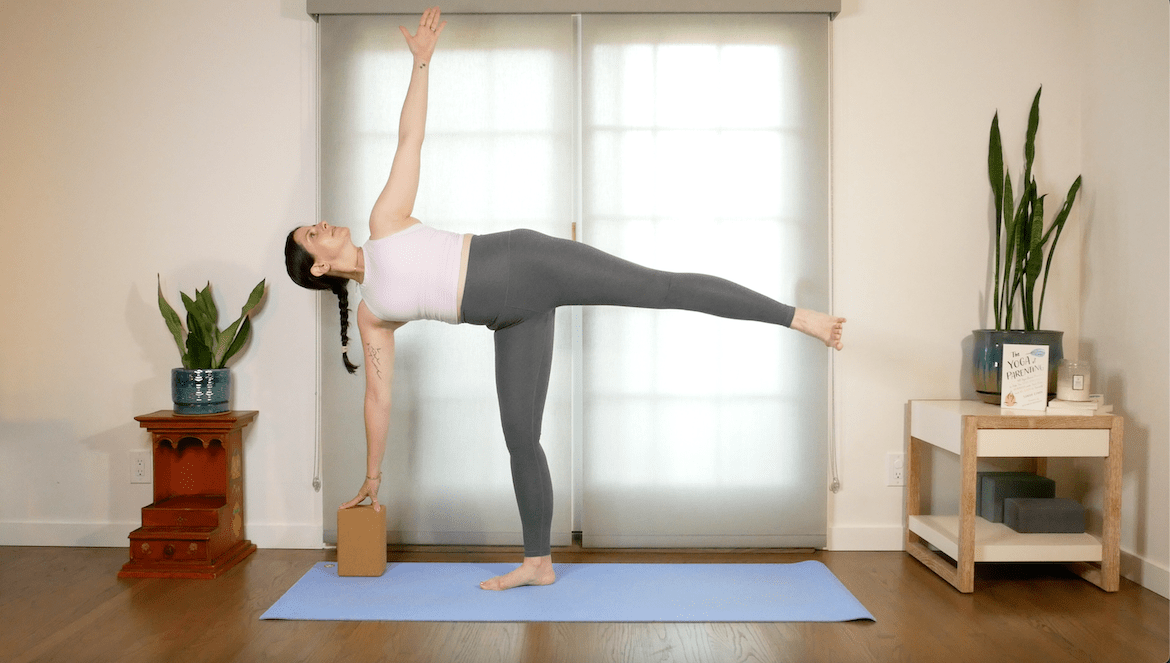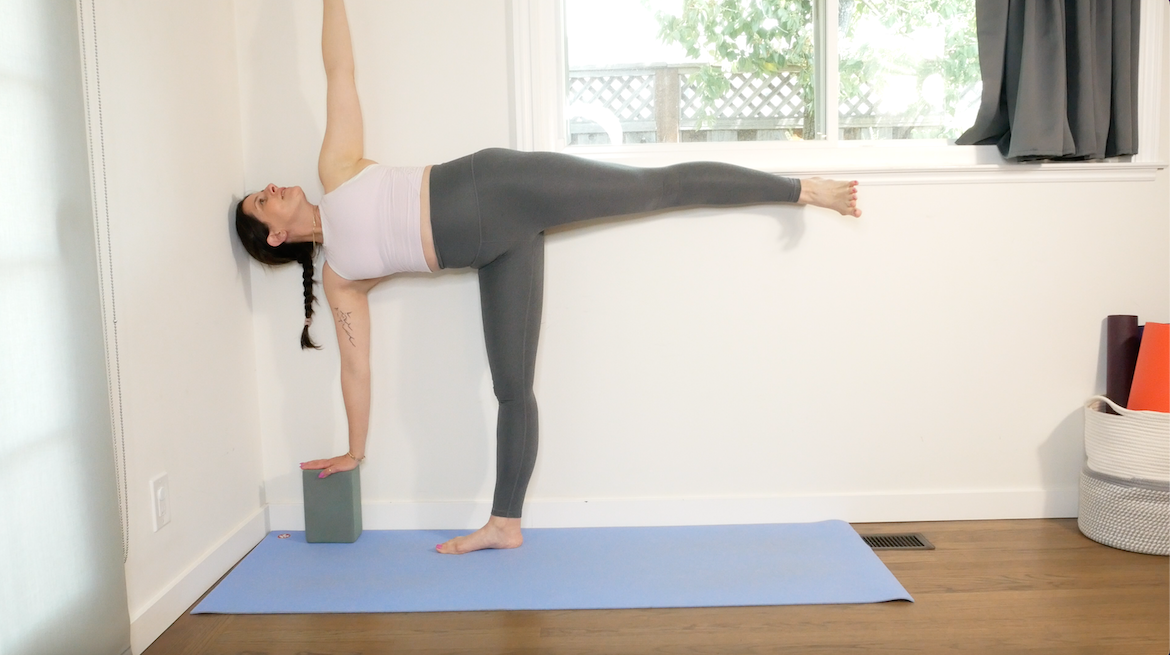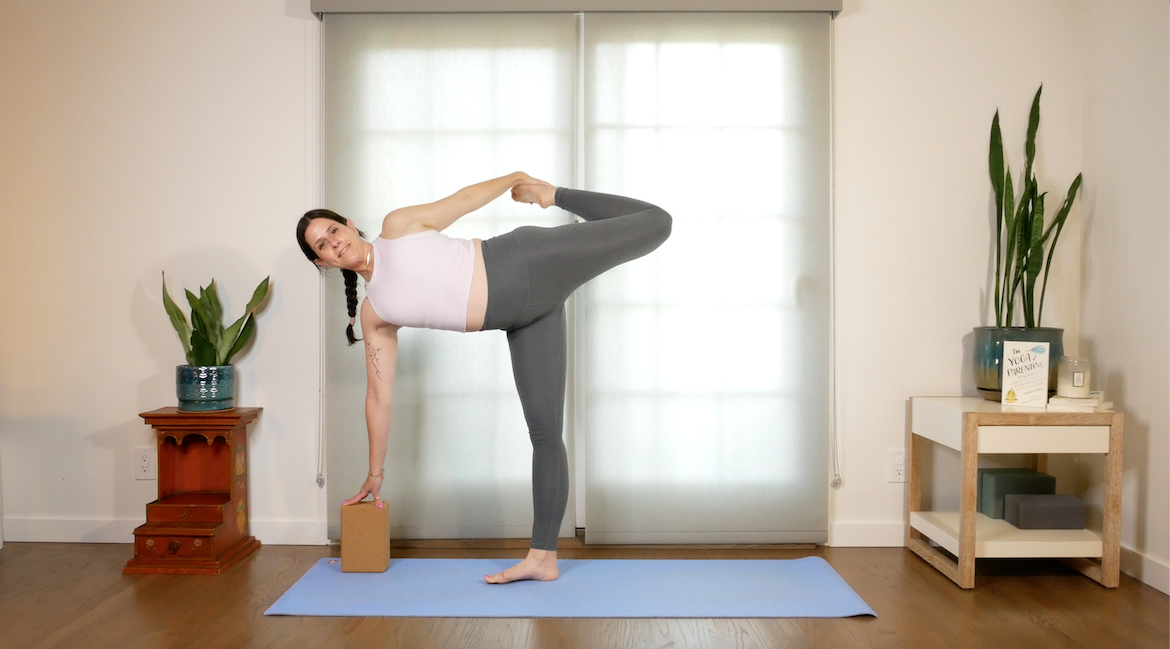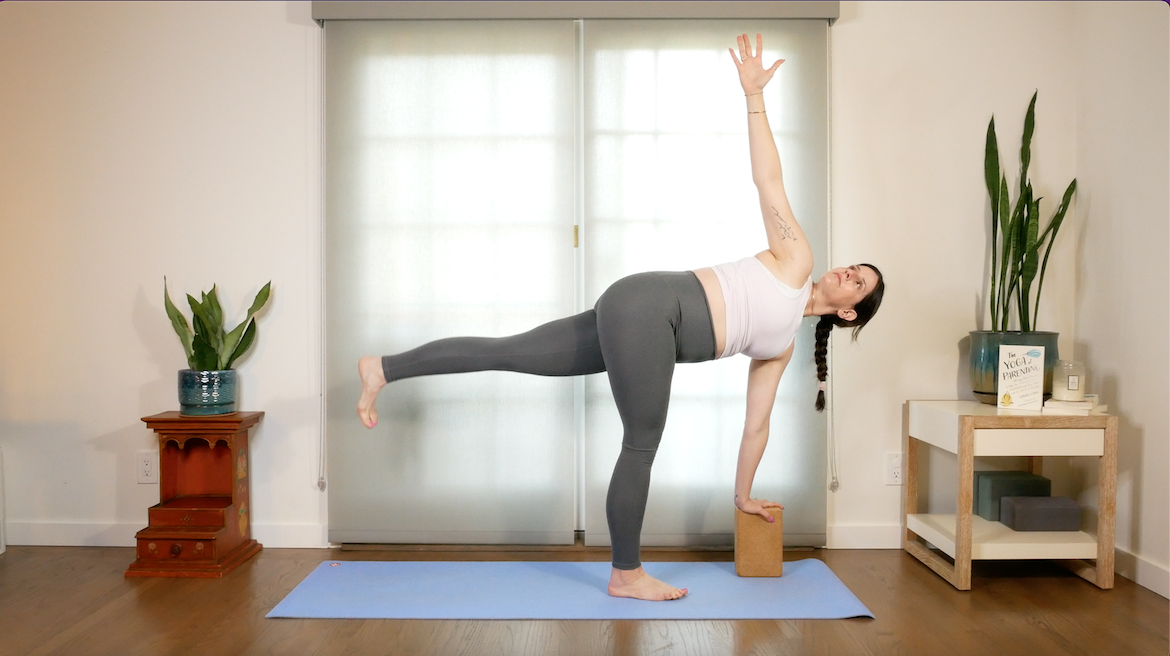Yoga’s iconic half moon pose (ardha chandrasana), with its full-body form and acrobatic steadiness necessities, is certainly Instagrammable—however its most profound advantages exist beneath the floor of its expansive outward look.
Although categorised as a standing posture, half moon can be thought-about a hip opener and chest opener. “One of many major advantages is that sense of opening by way of the entire physique,” says Jivana Heyman, RYT-500, founding father of Accessible Yoga. “It’s just like the physique is a five-pointed star and you may really feel your power and lightweight increasing in all instructions.”
This yoga for steadiness pose can also be a strong alternative for us to observe acceptance over perfection. Sabrina Zellis, RYT-500, has been instructing for practically a decade and he or she nonetheless topples over at instances.
“As an alternative of it as a failure or that I am not ‘reaching’ the pose, I view it as an off day and giggle about it,” she says. In reality, what makes this pose superior is much less that it is a single-leg train and extra the deeper religious lesson of not attaching to the outcomes of our efforts.
Along with firming our legs and butt and bettering steadiness, half moon teaches us to remain grounded, whilst we attain for the celebrities. Chakrically talking, our energetic roots start on the base of our backbone and prolong by way of and past the highest of our head. Half moon suggestions us on our aspect, asking us to search out the weather of rooting and rising whereas free-floating in house—not in contrast to attempting to get grounded on the moon.
Advantages of half moon pose
This balancing posture is a whole-body and whole-mind expertise.
Improves steadiness
“Stability is not simply bodily; it additionally has a major psychological element,” explains Zellis, who’s at the moment managing Coachella Yoga, Remedy, and Wellness in Palm Desert, California. “I’ve observed that my means to steadiness in half moon displays the sort of day I’ve had—it is a fantastic indicator of my psychological focus and readability.”
“I’ve observed that my means to steadiness in half moon displays the sort of day I’ve had—it is a fantastic indicator of my psychological focus and readability.”—Sabrina ellis, RYT-500
Improved steadiness will be particularly vital for older populations, who’re at greater threat of damage from random falls (we offer supported variations of the pose).
Strengthens the glutes
The standing leg is accountable for supporting our pelvis, lifted leg, and torso as we steadiness. With the intention to help these constructions, we should correctly have interaction our glute group, which incorporates our gluteus maximus (bum) and glute medius (outer hips). “The entrance leg is the unsung hero of the pose,” says Zellis. “It is just like the conductor of an orchestra, main the best way for the remainder of the physique to comply with swimsuit.”
Boosts ankle energy
You understand how wobbly your foot will get once you attempt to steadiness on one leg? That’s truly an excellent factor! It’s all the muscle groups of your toes and ankles calibrating that can assist you discover your middle. In reality, wobble-boards are sometimes used to assist athletes retrain ankle stability after damage.
Improves core stability
Core stability is having the ability to transfer our limbs whereas our trunk stays regular. “Whereas [half moon pose] is usually related to leg energy, there’s vital core engagement concerned in sustaining the pose. In spite of everything, our limbs connect to the middle of our physique,” laughs Zellis.
Might enhance cardiorespiratory endurance
A 2015 examine1 wanting on the results of yoga sufferers’ cardiorespiratory endurance (coronary heart, lung, and blood vessel synchrony and well being) noticed vital enhancements after a 12-week yoga intervention, the place half moon pose was one of many poses taught to analysis individuals.
Find out how to do half moon pose
We have damaged down the half moon sequence right into a step-by-step information beneath.

- Begin in triangle pose along with your legs three to 4 toes aside and your proper foot and leg turned ahead. Have your backside hand in your outer shin or a block. Place your high hand in your hip to start.
- Bend your proper knee and stroll your proper hand in entrance of your foot just a few inches. Use a block if it doesn’t attain the ground simply.
- On an inhale, elevate your left leg towards the sky.
- Straighten your standing leg.
- Agency your entrance hip in and underneath, when you roll your chest open. It is going to really feel as if you’re leaning your torso open in house (you’re!).
- Attain your high arm strongly upward (or hold it in your hip if steadiness feels challenged).
- Stare upon your standing foot or as much as your high hand.
- Stay for seven breaths.
- To return out, bend your standing knee, transfer your backside hand again subsequent to your foot, and slowly step your left leg again, returning to triangle pose.
- On an inhale, press your toes to convey your torso upright.
- Parallel your toes and swap sides.
5 kind suggestions that can assist you nail half moon
1. Prioritize your standing foot
“Focus totally on the grounding side,” advises Heyman. “Grounding is that feeling of power shifting down into the earth.” Though, in case your entrance foot shouldn’t be well-aligned to start with, no quantity of grounding will assist, factors out Zellis: “In case your foot veers off-course, it throws the entire get together out of whack! It additionally places pointless stress in your knee.”
2. Keep a gradual gaze
There is no such thing as a “proper” place to look—it’s as much as your steadiness and wish, so long as your eyes are regular. Some individuals look down at their standing foot, whereas others courageous a peek at their high arm.
3. Energize your lifted leg
Lots of people get so caught up in stabilizing the standing leg, they overlook concerning the lifted leg. The upper the lifted leg can elevate, the lighter your standing leg will really feel. That stated, Heyman has observed the deal with upward power will be destabilizing for some of us, and reminds you to prioritize grounding first (see tip no 1!).
4. Energize your arms
The arms could appear to be a fairly add on, however they’re truly an enormous contributor to our equilibrium. The underside hand acts as a second foot, whereas our high arm helps hold a way of buoyancy within the higher physique.
5. Keep centered
Maintain your consideration in your physique and your breath. This is usually a troublesome yoga pose to grasp if you happen to’re distracted. “I’m extra prone to fall if I’ve loads of stuff on my thoughts,” admits Zellis. Even in case you are wobbling, so long as your thoughts is targeted, you’re doing the pose properly.
“Even in case you are wobbling, so long as your thoughts is targeted, you’re doing the pose properly.”
Half moon pose variations
There are a selection of how to make half moon pose extra accessible— or more difficult—relying in your wants. Realizing modify a yoga pose is a crucial side of studying that your observe is for you, and never the opposite manner round.
And don’t let the accessible variations idiot you into considering they’re “straightforward”! Working with gadgets like a wall, chair, or block can typically make a pose more difficult—they act as reality tellers. It’s rather a lot more durable to compensate and let your bum jut to the aspect or on your standing foot and leg to be off-kilter when you will have a wall instantly behind you.
It’s vital to notice right here that there’s one other model of half moon pose taught in Bikram and some different lineages, which is a aspect stretch. That is the model that trainer Hailey Kinter, often known as @disabledyogi on Instagram, was taught and likewise teaches. Kinter shares a seated variation of that model beneath.
Half moon pose with again in opposition to wall
This can be a nice variation to implement how a lot your standing leg and hip work to maintain your lifted leg and higher physique secure on this pose. The wall can also be supportive if steadiness is a problem.

- Stand along with your again in opposition to the wall and separate your toes three toes aside, establishing for triangle pose.
- Flip your proper leg ahead and angle your again foot and hip barely inward.
- Attain your arms broad out to the edges.
- On an exhale, hinge at your hips and relaxation your proper hand in your outer proper shin.
- Look down and bend your proper knee.
- Place your backside hand barely forward of your toes on a block.
- Protecting your standing hip hooked in opposition to the wall, slowly elevate your left leg towards the ceiling.
- Straighten your standing knee.
- As soon as balanced, belief the wall to help you and lean your higher physique again in opposition to it. Maybe attain your high arm to the sky.
- While you really feel secure, you may look as much as your high hand, or hold your gaze towards the ground.
- Stay for seven breaths.
- Come again by way of triangle pose.
- Carry your torso and parallel your toes.
- Repeat in your left aspect.
Bikram yoga half moon pose
Bikram half moon pose is the standing model of the aspect bend we point out above. This form is typically known as crescent moon pose in different lineages.

- Stand on the high of your mat along with your toes collectively or hip-width for added stability.
- Inhale your arms as much as the ceiling and contact your palms collectively.
- On an exhale, lean your torso towards the best.
- You possibly can stay wanting ahead or look towards your palms.
- Maintain for 10 breaths.
- Use an inhale to convey your self again as much as middle and swap sides.
Half moon pose with a chair
There are fairly just a few methods to make the most of a chair to assist your half moon shine much more brightly.
Hand on chair
 Typically a block shouldn’t be excessive sufficient for us to really feel secure and spacious, so Heyman prefers utilizing a chair in his private observe. “I battle with poses that demand a number of issues of my decrease again and pelvis concurrently, because of a degenerated disc in my lumbar backbone. This adaptation permits me to discover a extra light manner into the pose that feels supportive.”
Typically a block shouldn’t be excessive sufficient for us to really feel secure and spacious, so Heyman prefers utilizing a chair in his private observe. “I battle with poses that demand a number of issues of my decrease again and pelvis concurrently, because of a degenerated disc in my lumbar backbone. This adaptation permits me to discover a extra light manner into the pose that feels supportive.”
Facet bend in chair

Kinter teaches the aspect bend model of half moon seated in a chair, and he or she jokingly prefers to name this model “banana-asana.” “It’s my favourite asana! I am seated each time I am not laying down, which may trigger my backbone to get extremely stiff and acquire pressure,” she says. “This model of half moon stretches the complete aspect of your physique.”
Chapasana (sugarcane pose)
As soon as you’re feeling assured within the classical one-legged steadiness form, you can begin to include some flare. Sugarcane pose provides a backbend and entrance physique stretch.

- Begin in half moon pose in your mat.
- Bend your lifted leg as if you could possibly kick your heel to your bum.
- Attain again along with your left hand and seize the foot, ankle, or shin.
- If the foot feels extremely distant, lasso a yoga strap or hand towel round it.
- Lean again to roll your chest open.
- Maintain for 5 breaths.
- Let the leg go slowly (it may really feel spring-loaded!).
- Return by way of half moon pose and both step again by way of triangle or come as much as stand.
- Repeat on the opposite aspect.
Twisted half moon pose
Typically known as revolved half moon pose, this model is extra of a cousin than a sibling. It’s a fantastic variation for difficult steadiness and breath.

- Begin in a runner’s lunge place, along with your proper foot ahead and a block beneath every hand.
- On an inhale, push off your entrance leg and elevate your left leg to hip top.
- Stroll your blocks just a few inches ahead till they’re instantly beneath your shoulders.
- Maintain your left hand on the block and produce your proper hand to your hip.
- Take an inhale to elongate your backbone.
- On an exhale, start to twist your torso open.
- Take into account reaching your proper arm as much as the ceiling.
- Stay for 5 breaths.
- On an exhale, unwind your twist, bringing your palms again to your blocks.
- Step again right into a runner’s lunge.
- Repeat on the opposite aspect.










